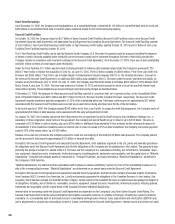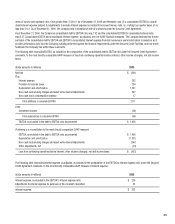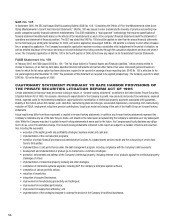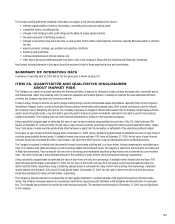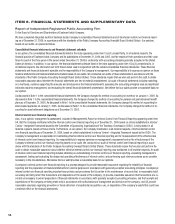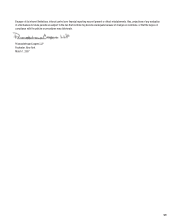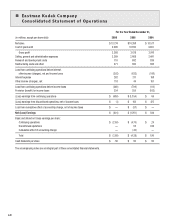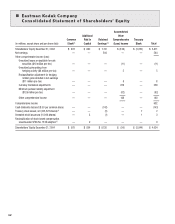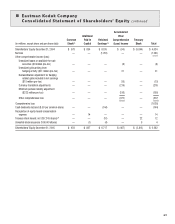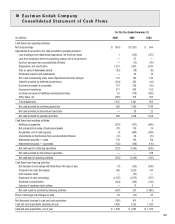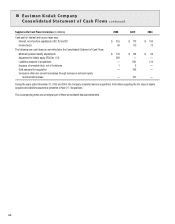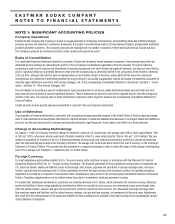Kodak 2006 Annual Report Download - page 64
Download and view the complete annual report
Please find page 64 of the 2006 Kodak annual report below. You can navigate through the pages in the report by either clicking on the pages listed below, or by using the keyword search tool below to find specific information within the annual report.
The forward-looking statements contained in this report are subject to the following additional risk factors:
• inherent unpredictability of currency fluctuations, commodity prices and raw material costs;
• competitive actions, including pricing;
• changes in the Company’s debt credit ratings and its ability to access capital markets;
• the nature and pace of technology evolution;
• changes to accounting rules and to tax laws, as well as other factors which could impact the Company’s reported financial position or effective
tax rate;
• general economic, business, geo-political and regulatory conditions;
• market growth predictions;
• continued effectiveness of internal controls; and
• other factors and uncertainties disclosed from time to time in the Company’s filings with the Securities and Exchange Commission.
Any forward-looking statements in this report should be evaluated in light of these important factors and uncertainties.
SUMMARY OF OPERATING DATA
A summary of operating data for 2006 and for the four years prior is shown on page 124.
ITEM 7A. QUANTITATIVE AND QUALITATIVE DISCLOSURES
ABOUT MARKET RISK
The Company, as a result of its global operating and financing activities, is exposed to changes in foreign currency exchange rates, commodity prices,
and interest rates, which may adversely affect its results of operations and financial position. In seeking to minimize the risks associated with such
activities, the Company may enter into derivative contracts.
Foreign currency forward contracts are used to hedge existing foreign currency denominated assets and liabilities, especially those of the Company’s
International Treasury Center, as well as forecasted foreign currency denominated intercompany sales. Silver forward contracts are used to mitigate
the Company’s risk to fluctuating silver prices. The Company’s exposure to changes in interest rates results from its investing and borrowing activities
used to meet its liquidity needs. Long-term debt is generally used to finance long-term investments, while short-term debt is used to meet working
capital requirements. The Company does not utilize financial instruments for trading or other speculative purposes.
Using a sensitivity analysis based on estimated fair value of open forward contracts using available forward rates, if the U.S. dollar had been 10%
weaker at December 31, 2006 and 2005, the fair value of open forward contracts would have increased $2 million and decreased $29 million, respec-
tively. Such gains or losses would be substantially offset by losses or gains from the revaluation or settlement of the underlying positions hedged.
There were no open forward contracts hedging silver at December 31, 2006. Using a sensitivity analysis based on estimated fair value of open forward
contracts using available forward prices, if available forward silver prices had been 10% lower at December 31, 2005, the fair value of open forward
contracts would have decreased $3 million. Such losses in fair value were offset by lower costs of manufacturing silver-containing products.
The Company is exposed to interest rate risk primarily through its borrowing activities and, to a lesser extent, through investments in marketable secu-
rities. The Company may utilize borrowings to fund its working capital and investment needs. The majority of short-term and long-term borrowings are
in fixed-rate instruments. There is inherent roll-over risk for borrowings and marketable securities as they mature and are renewed at current market
rates. The extent of this risk is not predictable because of the variability of future interest rates and business financing requirements.
Using a sensitivity analysis based on estimated fair value of short-term and long-term borrowings, if available market interest rates had been 10%
(about 63 basis points) higher at December 31, 2006, the fair value of short-term and long-term borrowings would have decreased less than one
million and $59 million, respectively. Using a sensitivity analysis based on estimated fair value of short-term and long-term borrowings, if available
market interest rates had been 10% (about 63 basis points) higher at December 31, 2005, the fair value of short-term and long-term borrowings
would have decreased $2 million and $68 million, respectively.
The Company’s financial instrument counterparties are high-quality investment or commercial banks with significant experience with such instru-
ments. The Company manages exposure to counterparty credit risk by requiring specific minimum credit standards and diversification of counterpar-
ties. The Company has procedures to monitor the credit exposure amounts. The maximum credit exposure at December 31, 2006 was not significant
to the Company.



